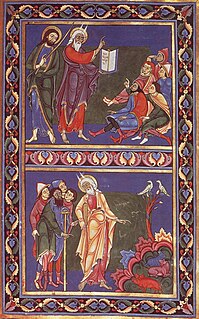
The Basilica of Saint-Denis is a large medieval abbey church in the city of Saint-Denis, now a northern suburb of Paris. The building is of singular importance historically and architecturally as its choir, completed in 1144, shows the first use of all of the elements of Gothic architecture.
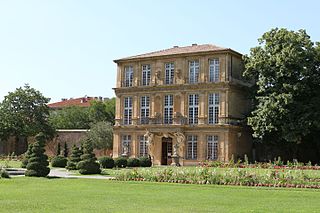
Aix-en-Provence, or simply Aix, is a city and commune in Southern France, about 30 km (19 mi) north of Marseille. A former capital of Provence, it is in the region of Provence-Alpes-Côte d'Azur, in the department of Bouches-du-Rhône, of which it is a subprefecture. The population of Aix-en-Provence numbers approximately 143,000. Its inhabitants are called Aixois or, less commonly, Aquisextains.

The term Black Madonna or Black Virgin refers to statues or paintings of the Blessed Virgin Mary in which she, and often the infant Jesus, are depicted with black or dark skin. The Black Madonna can be generally found in Catholic and Orthodox countries.

Digne-les-Bains, or simply and historically Digne, is a commune of France, capital of the Alpes-de-Haute-Provence department, and situated in the region of Provence-Alpes-Côte d'Azur. The name of its inhabitants is Dignois. It had a population of 17,268 as of 2008.
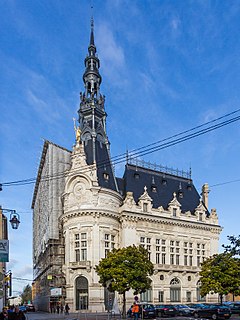
Sens is a commune in the Yonne department in Bourgogne-Franche-Comté in north-central France, 120 km from Paris.

The Church of St. Trophime (Trophimus) is a Roman Catholic church and former cathedral located in the city of Arles, in the Bouches-du-Rhône Department of southern France. It was built between the 12th century and the 15th century, and is in the Romanesque architectural tradition. The sculptures over the church's portal, particularly the Last Judgement, and the columns in the adjacent cloister, are considered some of the finest examples of Romanesque sculpture.
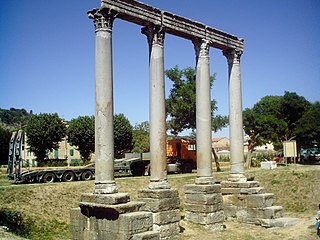
Riez is a commune in the Alpes-de-Haute-Provence department in southeastern France.
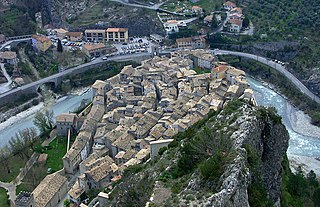
Entrevaux is a commune (municipality), former episcopal seat and Latin Catholic titular see in the Alpes-de-Haute-Provence department in southeastern France.
The Festival International d'Art Lyrique d'Aix-en-Provence is an annual international music festival which takes place each summer in Aix-en-Provence, principally in July. Devoted mainly to opera, it also includes concerts of orchestral, chamber, vocal and solo instrumental music.

Aix Cathedral in Aix-en-Provence in southern France is a Roman Catholic church and the seat of the Archbishop of Aix-en-Provence and Arles. The cathedral is built on the site of the 1st century Roman forum of Aix. Built and re-built from the 12th until the 19th century, it includes Romanesque, Gothic and Neo-Gothic elements, as well as Roman columns and parts of the baptistery from a 6th-century Christian church. It is a national monument of France.

The Metropolitan Cathedral–Basilica of the Assumption of Our Lady of Valencia, alternatively known as Saint Mary's Cathedral or Valencia Cathedral, is a Roman Catholic parish church in Valencia, Spain.

Fréjus Cathedral is a Roman Catholic church located in the town of Fréjus in the Var department of Provence, southeast France, and dedicated to Saint Leontius of Fréjus.

The Cathedral of St Peter the Apostle is a Roman Catholic church located in Jaca, in Aragon, Spain. It is the seat of the Roman Catholic Diocese of Jaca.
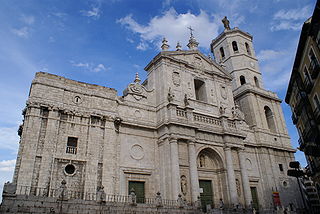
The Cathedral of Our Lady of the Holy Assumption, better known as Valladolid Cathedral, is a Roman Catholic church in Valladolid, Spain. The main layout was designed by Juan de Herrera in a Renaissance-style.
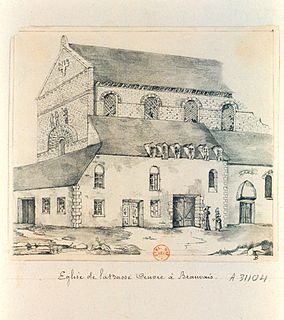
The Basse Œuvre, in full the Parish Church of Our Lady of the Basse Œuvre of Beauvais, is a church at the west end of Beauvais Cathedral, dated to the 10th century. It was classed as a historic monument in the list of 1840. It is the west end remnant of a much longer church which had been Beauvais' cathedral. It was built in the form of a Roman basilica, a style which still characterized the Carolingian era.

Ourense Cathedral is a Roman Catholic church located in Ourense in northwestern Spain. Dedicated to St Martin, it was founded in 550. The first structure was restored by Alonso el Casto. The present mainly Gothic building was raised with the support of Bishop Lorenzo in 1220. Its local patroness is Saint Euphemia. There is a silver-plated shrine, and others of St Facundus and St Primitivus. The Christ's Chapel was added in 1567 by Bishop San Francisco Triccio. It contains an image of Christ, which was brought in 1330 from a small church on Cape Finisterre. John the Baptist's Chapel was created in 1468 by the Conde de Benavente. The Portal of Paradise is sculptured and enriched with figures of angels and saints, while the antique cloisters were erected in 1204 by Bishop Ederonio. The Capilla de la Maria Madre was restored in 1722, and connected by the cloisters with the cathedral. The eight canons were called Cardenales, as at Cathedral of Santiago de Compostela, and they alone did services before the altar; this custom was recognised as "immemorial" by Pope Innocent III, in 1209. The cathedral, which has undergone an impressive transition of architectural styles of Romanesque, Gothic, Renaissance, Baroque and Neoclassical, was built to a Latin Cross plan. It has been a functional basilica since 1887. The cathedral has a crucifix that is held in great reverence all over Galicia.
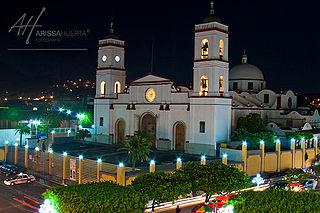
The St. Joseph and St. Andrew Cathedral Also San Andrés Tuxtla Cathedral It is a catholic temple that is located in the city of San Andrés Tuxtla, in Mexico. It dominates the center of the town with its two towering sotaventino colonial style towers, the beginning of its construction dates from the late nineteenth and mid twentieth century. Its construction covers almost 100 years, mainly because of the lack of resources in the process, being strong impetus Mrs. Concepcion Sedas in its culmination in the year of 1950. Both the interior and the exterior are painted of clear colors, inside This chapel of the Santísimo where the rest of the bishop Guillermo Ranzahuer is found. Four bishops have exercised their pastoral work in this Diocese. This cathedral was consecrated by Don Jesus Villareal and Fierro on January 7, 1950 and was completed with the contributions of the faithful and religious.







